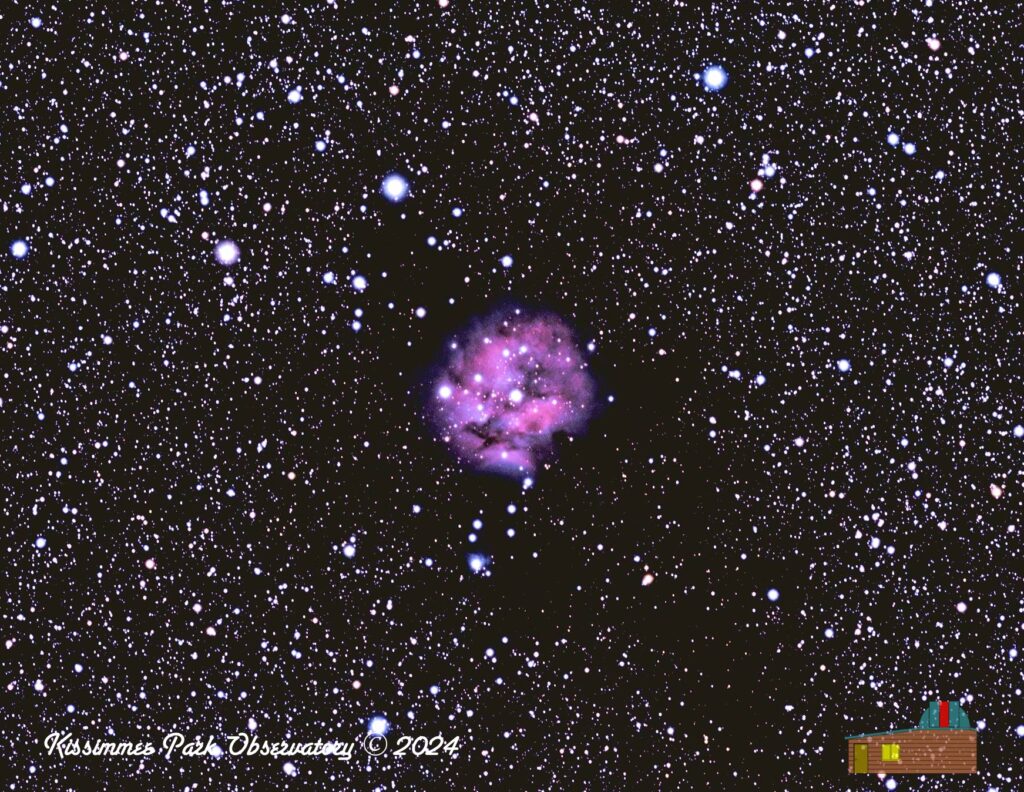
The Cocoon Nebula in Cygnus, as captured by the WFAC (Askar 400 Astrograph). This LRGB image had a total integration time of 6.7 hours.
The Cocoon Nebula: A Stellar Nursery in Cygnus
In the vast tapestry of the cosmos, nestled within the constellation Cygnus, lies a celestial wonder known as the Cocoon Nebula, or IC 5146. This blog post will take you on a journey through the dark interstellar clouds to discover what makes this nebula not only a gem for astrophotographers but also a hotbed for stellar nurseries.
What is the Cocoon Nebula?

This is the original uncropped image that shows the full extent of the dark nebula, nicknamed “The Caterpillar”. Click for a full size image you can explore.
The Cocoon Nebula is a reflection and emission nebula, which means it shines by reflecting the light of nearby stars and also emits its own light due to the ionization of gas within it. It’s cataloged as IC 5146, indicating it’s part of the Index Catalogue, a list of astronomical objects published in the late 19th and early 20th centuries.
- Location: Situated about 4,000 light-years away in the Cygnus constellation, near the well-known asterism called the Northern Cross.
- Formation: The nebula is an active star-forming region, where new stars are born from the collapse of gas and dust clouds. The Cocoon Nebula is particularly notable for its association with a young cluster of stars, BD+46°3474, whose members light up the nebula.
Astrophotography and Observation
For amateur astronomers and astrophotographers, the Cocoon Nebula presents a delightful challenge. While it’s faint and requires a dark sky to be observed, it can be seen with moderate-sized telescopes. However, its beauty truly unfolds under larger apertures or through astrophotography.
Scientific Significance
- Star Formation: The Cocoon Nebula serves as a laboratory for studying how stars form. By observing the interactions between the nascent stars and the surrounding nebula, astronomers gain insights into the lifecycle of stars.
- Molecular Cloud: The nebula is part of a giant molecular cloud, which is essentially a vast reserve of material from which stars are born. This region is rich in hydrogen, the primary building block for star formation.
The Future of IC 5146
The Cocoon Nebula, like all celestial nurseries, is a transient phenomenon. Over millions of years, the stars will clear out the nebula with their radiation and stellar winds, dispersing the material that once shielded them in their infancy. However, this process also seeds the interstellar medium with new material for future generations of stars.
Final Notes
The Cocoon Nebula, IC 5146, is more than just a picturesque object in the night sky; it’s a dynamic region where the universe actively engages in the creation of new stars. Whether you’re an astrophotographer aiming to capture its ethereal beauty or an amateur astronomer peering through your telescope, or a professional studying the intricacies of star formation, IC 5146 offers a profound connection to the cosmic processes that shape our universe.
Next time you gaze up at Cygnus, remember, within the dark lanes and glowing clouds, stars are being born, wrapped in the protective embrace of the Cocoon Nebula.
Image Info
- Imaged from Chiefland Astronomy Village, Chiefland, FL (Bortle 4)
- Camera : ZWO ASI1600MM Pro
- Scope: Askar 400 Quintuplet Astrograph f/5.6
- Mount: iOptron Smart-EQ Pro
- Luminance: 30 subframes of 300s = 150 min integration
- Red: 16 subframes of 300s = 80 min integration
- Green: 17 subframes of 300s = 85 min integration
- Blue: 17 subframes of 300s = 85 min integration
- Total integration time: 400 min = 6.7 hours.
- Captured via ASIAir Pro automation
- Optical tracking via ASIAir automation via the ASI120MM-S guide camera
- Separate channels stacked and LRGB integrated in Astro Pixel Processor
- Image run through Super DeNoising
- Final processing in Aperture
